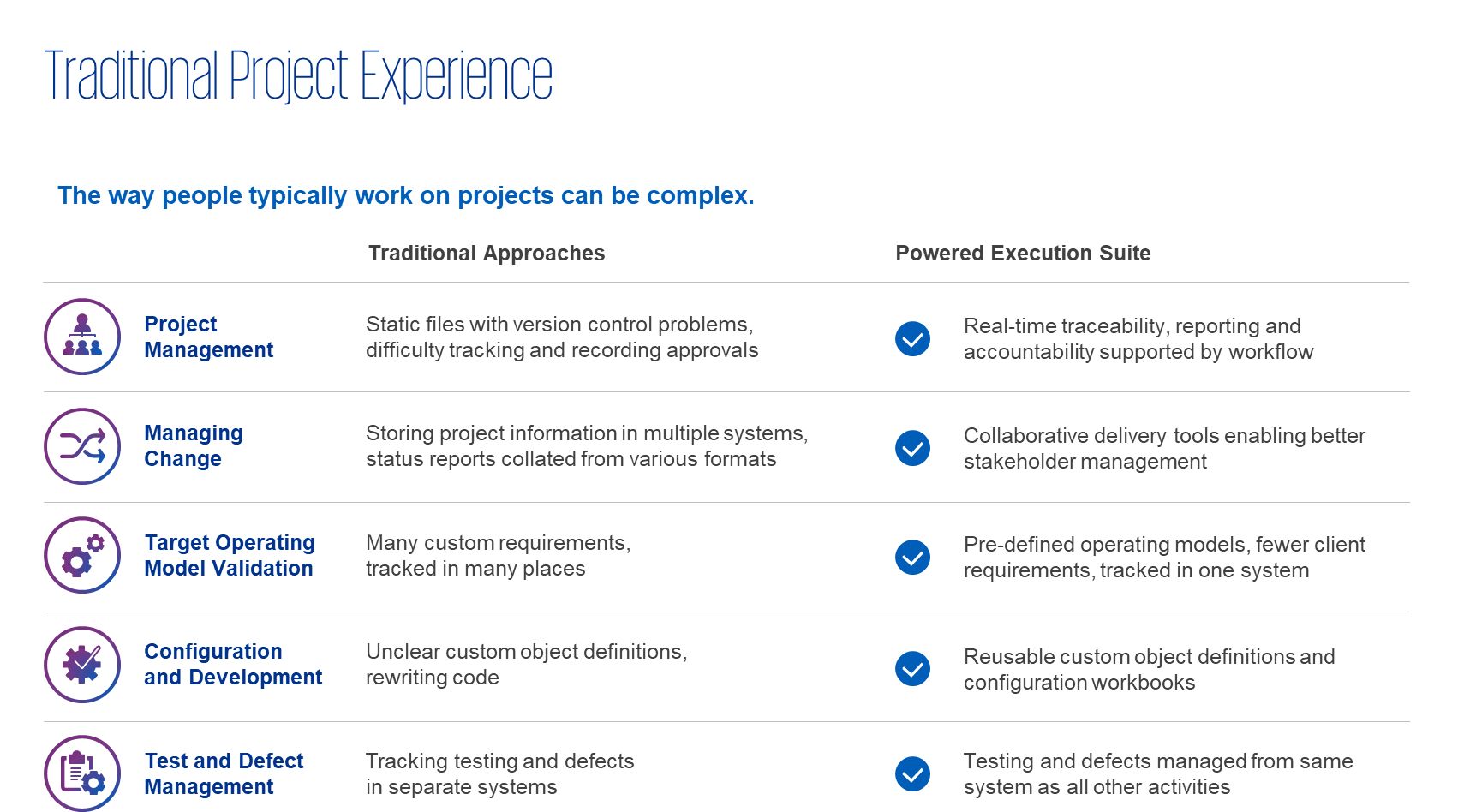L'essentiel
Executive Summary
When preparing to make their next big investment, all firms face the same set of challenges even though they may have different goals behind making acquisitions.
Private equity may be looking to enable the growth of the company they are buying, increase or support major development projects.They could also simply have a buy-to-sell strategy. Experience shows however that whether they have a one-time, short or medium term value creation strategy, the main challenges remain the same, these being how to steer the company or entity they are buying through a transition of rapid performance improvement and how to manage talent in a way that best aligns with current and future business demands.
In addition to these acquisition questions, private equity and corporates face an other set of challenges related to IT, especially if they are willing to set a stand-alone carve-in, or create a build-up. In such a context, they may face two different scenarios: the acquired company may benefit from TSA from the seller, or on the contrary, the acquired company keeps the responsibility on the existing information system and must be autonomous. Information System is even more critical in these two cases and rebuilding it, to leave TSA or to have state-of-the art solutions, is a winning strategy.
This article is meant to explain how firms and private equity, whether they have standalone or build-up strategies, can overcome such challenges.
What are the major IT-related acquisition challenges and how to address them ?
Experience has showed us that successful M&A deals go hand in hand with carefully planned and managed IT transition activities. Beyond IT integration, an IT transformation strategy is necessary to achieve the expected synergies. Reducing risks during these IT transformations remains on top of the agenda of successful acquirers.
However, when performing an acquisition, avoiding IT risks while also realizing potential value is challenging. In fact, the complexity is further compounded by the fact that private equity needs to overcome a list of IT-related challenges, among which:
- Perform the integration in a limited timeline even though key activities must be performed (identify business needs, implement the defined solutions and services, ensure transition from data migration to change management…)
- Manage obsolescence
- Achieve interoperability
- Reduce risks and enhance ROI
- Ensure business continuity at Day 1, especially when Private Equities do not have necessarily the operational capabilities in terms of information system management (e.g. compared with Corporates)
- Perform business transformation while an IT transformation is ongoing
- Adapt the corporate culture in order to secure collaboration between employees from both parties
In order to address IT transformation challenges and accelerate added-value capture post-closing, pre-configured Cloud solutions are a strong lever to focus on business value and align business functions.
So, how may pre-configured Cloud-based ERP solutions help solve common acquisition challenges?
As explained earlier, what is important to investors is to generate more business value. So most preferably, the IT should be simple to carve-out or combine. This is when cloud-based ERP solutions should be taken into consideration in M&A implementations. According to KPMG’s Cloud Survey Report, Cloud is not only a transformative solution that helps organizations engage strategic initiatives and achieve strategic goals. It can also be essential to the actual execution of transformation and a driver for value creation.
Cloud-based ERP solutions are technological enablers. Combining or carving out processes and systems could be very challenging, but Cloud-based ERP solutions had proven to be the key to an easier integration, a simpler collaboration and a faster completion. In addition to that, an ERP based on Cloud technologies contributes in value creation – or at least avoid value destruction – especially in a Build-up scenario where the private equity’s goal is to sell the firm. It reassures potential buyers that key challenges have been anticipated, specifically regarding the obsolescence. In fact, by using a cloud-based ERP, companies can prevent many problems that plague organizations relying on on-premises IT infrastructures face. Two main advantages are offered: efficiency and cost reduction. There is no more need to spend huge amounts of money on purchasing and maintaining equipments. It also guarantees flexibility which can make a significant difference to the overall efficiency of any organization. Cloud is an opportunity for companies to reinvent and transform their business processes. This being said, Cloud is the answer to information system obsolescence and the solution for businesses to stay up-to-date regarding technology. Another challenge that could be faced is interoperability. These solutions comply with the latest protocols and ensure an easy communication / data transfer using API.
Beyond the technological aspects, Cloud-based ERP solutions are business accelerators. These solutions are well-known as strong assets for business process streamlining. For example, they provide standardized and optimized Master Data Models. In such a digital era, it is definitely a growth enabler.
A pre-configured cloud-based ERP solution is the key to address major IT-related acquisition challenges
In addition to avoiding the risks of obsolescence and improving interoperability, a pre-configured cloud-based solution addresses other challenges. It allows companies to save implementation time. By saving a considerable amount of it, it guarantees the acceleration of complex IT transformations and the reduction of the risks related to these transformations. It not only allows companies to save time but also energy. The interest that comes with adopting a pre-configured solution is also to be able to help employees focus on core business tasks and on what is important. Since most of the business processes are already designed and integrated, Buisness Analysts will be dedicated to matters that actually bring value to the organization. This way, business-related risks are minimized, and operations are secured while an IT Transformation is ongoing. These are two of the main factors leading to an enhanced ROI while performing an IT transformation.
It is important to note that firms should be considering a Greenfield approach in order to benefit the most from a pre-configured ERP solution. But, before moving further in the conversation, it’s important to point out which considerations are to be taken into account before choosing its implementation strategy. A Greenfield approach is essentially a reset button. It is a complete reengineering of business processes and workflows, while a brownfield approach is in a certain way the exact opposite. Users need to reevaluate and edit their existing processes, and in addition to that, brownfield implementation is best done on-premise.
So, taking into consideration the essence of a pre-configured solution is not to reevaluate existing processes but to define new ones. Its adoption is only relevant if a Greenfield method is to be considered. It is also important to bring attention to another criteria to be considered by companies before thinking about choosing a pre-configured cloud-based solution which is the size of the company. Experience has showed that middle-market firms – revenues between €700m and €1.4b – are simply a better fit. In fact, small firms do not have the critical company size to adopt such frameworks. Large companies however have the ability and resources to engage a transformation where customization makes sense. Powered offers an accurate answer to middle-market firms that require to structure their tools in order to support their business leadership. They are nonetheless too small to derive from standard configuration of the tools, since Business and IT teams have to remain as lean as possible.
In order to successfully address these challenges, it appears to be essential not to overlook the value of change management. Let’s not forget that the bigger the acquisition, the more processes, IT infrastructure, job roles and culture need to change. To sum up, the way companies handle change is crucial to succeed aquisitions.
KPMG’s framework for Cloud Applications
KPMG brings a robust methodology and a proven solution called Powered Enterprise that helps private equity and companies secure their acquisitions and overcome the different challenges mentioned earlier. It is a pre-configured Cloud solution fully integrated that focuses on business value and aligns business functions. Powered Enterprise is not just about migrating finance or the supply chain into the cloud. It provides a combination of leading practices and processes as well as proven technology solutions with a next generation of delivery framework.
Powered Enterprise is an outcome-driven transformation solution that prepares businesses for the future. Investing in cloud solutions, target operating models, processes and tools gives private equity that are willing to uplift business value instant access to leading practices and predictable outcomes.
This solution contains:
- The Powered operating model which is a proven solution set that is ready to work (industry insights, validation workshop packs, pre-configured ERP solution, test scripts and protocols, process taxonomy, defined data models and reports, governance and controls…). It shapes how transformation plays through every layer of the organization and helps to start the project as soon as possible.

- The Powered execution suite (PES) is a set of project delivery execution tools designed to enhance, accelerate and reduce the risk of your Powered Enterprise engagement (Jira, Confluence, Clarizen…).

Powered has expanded from across a number of state-of-the-art technologies, chosen by KPMG experts, including SAP, Microsoft, Oracle, Workday. Regardless of the technology, the approach remains the same, to standardize and automate processes as much as possible by using 80% of the preconfigured solution and focus adaptation efforts on the remaining 20%. It is built on experience and insights.
Like explained earlier, making use of a pre-configured solution saves implementation time and reduces risk of the over-configuring through ERP specific process templates. Experience has showed that, thanks to Powered, implementation duration can be reduced up to 30% compared to a traditional one. Instead of lengthy process workshops to determine new process flows, Powered guarantees shorter process workshops with key decision makers to agree on pre-configured processes, focused on the 20% that are unique for the organization. As a result, the main focus will be on high value process areas. To sum up, unlike traditional implementations, Powered accelerates transformation allowing companies to jump start their digital transformation by validating pre-built operating models instead of time consuming AS-IS analysis. Along with providing the governance, organizational and operational assets, a full transformation can be achieved with a shorter time to value.

KPMG utilized Powered Enterprise for a company specialized in multiline insurance. This client has used two decades of M&A to add scale. When KPMG advised the company during its most recent acquisition, its executive team articulated a bold mandate: “use the post-merger consolidation to rethink the entire back-office as a foundation for continued growth”.
The Powered Enterprise approach allowed KPMG to handle the challenge. Simply put, Powered Enterprise is a project approach that includes a pre-configured cloud ERP solution based on leading practices. It includes all aspects of a client’s business, from process models, controls, organizational model, and roles descriptions to performance management, and was utilized to create a single cloud-based platform for all the company’s finance operations within a year. The major benefits are as follows:
- Two organizations successfully integrated with minimal disruption into a common technology platform designed to scale as the company makes future acquisitions
- Business processes for finance, payroll and human resources standardized, simplified and streamlined on a single, cloud-enabled Powered platform
- Enhanced management reporting put in place to support business strategy based on data that is now more timely, consistent, accurate and dependable.
Conclusion
Powered Enterprise is a compelling answer for private equity and companies looking for the opportunity to enhance performance in the short to medium term.
Clients who choose Powered Enterprise are looking for standardization, automation, improved reporting and predictive analytics. They appreciate that Powered Enterprise adapts to a number of cloud-based solutions and KPMG is deeply versed in these. It is especially relevant for Private equity that are willing to set a stand-alone carve-in, or create a build-up, where processes need to be reviewed and information systems need to be rebuilt from scratch. It is key to efficient integrations of acquisitions by delivering lower-risk business transformation, reducing risk of change and enhancing ROI.
Auteurs
| Amal Ben Ismail Senior Consultant, Technology Transformation |
| Etienne Turkovics Manager, Technology Transformation |
| Hugo Carreira Director, Technology Transformation |
| Josselin Du Plessis Associé, Technology Transformation |





